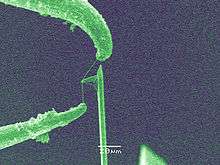Nanoknife

A nanoknife is a carbon nanotube-based prototype compression cutting tool intended for sectioning of biological cells.[1] Working principle is similar to that of a 'cheese slicer', a nanometer-thin individual carbon nanotube strung between two tungsten needles would allow sectioning of very thin slices of biological matter for imaging under an electron microscope. Tests are currently being performed by scientists at Virginia Tech, CU-Boulder and other universities.[2][3] A successful development of this new tool will allow scientists and biologists to make 3D images of cells and tissues for electron tomography, which typically requires samples less than ~300 nanometers in thickness.[2] In 2009, the nano-knife was used to create indentation marks on biological cell plasticizer (epoxy resin).[4] The whole cutting process is currently limited by electron charging of polymeric specimen in the SEM, which makes it difficult to observe any small cut or mark as the carbon nanotube is pressed against the specimen.
References
- ↑ On the Cutting Edge: Carbon Nanotube Cutlery, National Institute of Standards and Technology, 22 November 2006, retrieved 2010-03-19
- 1 2 G Singh; P Rice; R L Mahajan; J R McIntosh (11 February 2009), Fabrication and characterization of a carbon nanotube-based nanoknife, Volume 20, Number 9, Nanotechnology, Bibcode:2009Nanot..20i5701S, doi:10.1088/0957-4484/20/9/095701, retrieved 2010-03-19
- ↑ "Nanodevices Using Individual Carbon nanotubes", NanoScience and Engineering Group, Kansas State University, retrieved 2010-03-19
- ↑ "Spotlight", Cutting edge nanotechnology, Nanowerk, 18 February 2009, retrieved 2010-03-19
